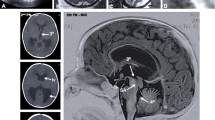Abstract
We studied the microscopic morphological changes in congenital hydrocephalus in the inbred rat, LEW/Jms, on gestational days 17, 18, and 20 and during the neonatal period to clarify the etiopathogenesis, focusing particularly on the aqueductal changes. At 1 day of age, ventriculomegaly was limited to the lateral and III ventricles, and the aqueduct was obstructed, with the appearance of simple stenosis. On gestational days 20 and 18, the hydrocephalic rats showed occluded aqueducts, which paralleled the finding of hydrocephalus in the newborn rats. On gestational day 17, all eight models examined showed the same size ventricles. However, an aqueductal obstruction was observed in one of them. The other seven rats showed the aqueduct patent. From these observations, it can be concluded that the rat shows an aqueductal obstruction on gestational day 17 and appears to develop hydrocephalus with age. The aqueductal obstruction was considered to be the primary change and not a secondary phenomenon. The site of obstruction was the anterior part of the aqueduct (level of anterior colliculus) at every stage. Aqueductal obstruction following the developmental anomaly of the midbrain in the embryonic stage might thus be the primary cause of congenital hydrocephalus in rats LEW/Jms.
Similar content being viewed by others
References
Adeloye A, Warkany J (1976) Experimental congenital hydrocephalus. A review with special consideration of hydrocephalus produced by zinc deficiency. Child's Brain 2:325–360
Aikawa H, Kobayashi S, Suzuki K (1986) Aqueductal lesions in 6-aminonicotinamide-treated suckling mice. Acta Neuropathol (Berl) 71:243–250
Berry RJ (1961) The inheritance and pathogenesis of hydrocephalus-3 in the mouse. J Pathol Bacteriol 81:157–167
Bicker DS, Adams RD (1949) Hereditary stenosis of the aqueduct of Sylvius as a cause of congenital hydrocephalus. Brain 72:246–262
Borit A, Sidman RL (1972) New mutant mouse with communicating hydrocephalus and secondary aqueductal stenosis. Acta Neuropathol (Berl) 21:316–331
D'Amato CJ, Oshea KS, Hicks SP, Glover RA, Annesley TM (1986) Genetic prenatal aqueductal stenosis with hydrocephalus in rat. J Neuropathol Exp Neurol 45:665–682
Drachman DA, Richardson EP (1961) Aqueductal narrowing, congenital and acquired. Arch Neurol 5:552–559
Edwards JH, Norman RM, Roberts JM (1961) Sex-linked hydrocephalus. Report of a family with 15 affected members. Arch Dis Child 36:481–485
Green MC (1970) The developmental effects of congenital hydrocephalus (ch) in the mouse. Dev Biol 23:585–608
Higashi K, Asahisa H, Ueda N, Noda Y, Tashiro M (1984) An experimental model of congenital hydrocephalus in the rat. Shoni no Noshinkei (Jpn) 9:257–264
Holmes LB, Nash A, ZuRhein GM, Levin M, Opitz M (1963) X-linked aqueductal stenosis: clinical and neuropathological findings in two families. Pediatrics 63:1104–1110
Jellinger G (1986) Anatomopathology of non-tumoral aqueductal stenosis. J Neurosurg Sci 30:1–16
Kohn DF, Chinookoswong N, Chou SM (1981) A new model of congenital hydrocephalus in the rat. Acta Neuropathol (Berl) 54:211–218
Koto M, Miwa M, Shimizu A, Tsuji K, Okamato M, Adachi J (1987) Inherited hydrocephalus in Csk; Wister-Imamichi rats; Hyd strain: a new disease model for hydrocephalus. Jikken Dobutsu 36:157–162
Kristensson K, Leestma J, Lundh B, Norrby E (1984) Sendai virus infection in the mouse brain: virus spread and long-term effects. Acta Neuropathol (Berl) 63:89–95
Nugent GR, Al Mefty O, Chou S (1979) Communicating hydrocephalus as a cause of aqueductal stenosis. J Neurosurg 51:812–818
Raimondi AJ, Clark SJ, McLone DG (1976) Pathogenesis of aqueductal occlusion in congenital murine hydrocephalus. J Neurosurg 5:66–77
Richardson RR (1985) Congenital genetic murie (ch) hydrocephalus. Child's Nerv Syst 1:87–99
Sasaki S, Goto H, Nagano H, Furuya K, Omata Y, Kanazawa K, Suzuki K, Sudo K (1983) Congenital hydrocephalus revealed in the inbred rat LEW/Jms. Neurosurgery 13:548–554
Sato H (1986) Experimental congenital hydrocephalus. Pathogenetic processes in differentiating brain. Neurol Med Chir (Tokyo) 26:11–18
Shibuta H, Adachi A, Kanda T, Shimada H (1978) Experimental parainfluenza virus infection. I. Hydrocephalus of mice due to infection with parainfluenza virus type 1 and 3. Microbiol Immunol 22:505–508
Stempark JG (1984) Etiology of trypan blue induced antenatal hydrocephalus in the albino rat. Anat Rec 148:561–571
Williams B (1973) Is aqueduct stenosis a result of hydrocephalus? Brain 96:399–412
Woollam DHM, Millen JW (1953) Anatomical consideration in the pathology of stenosis of the cerebral aqueduct. Brain 76:104–112
Author information
Authors and Affiliations
Rights and permissions
About this article
Cite this article
Yamada, H., Oi, S., Tamaki, N. et al. Prenatal aqueductal stenosis as a cuase of congenital hydrocephalus in the inbred at LEW/Jms. Child's Nerv Syst 7, 218–222 (1991). https://doi.org/10.1007/BF00249399
Received:
Revised:
Issue Date:
DOI: https://doi.org/10.1007/BF00249399




